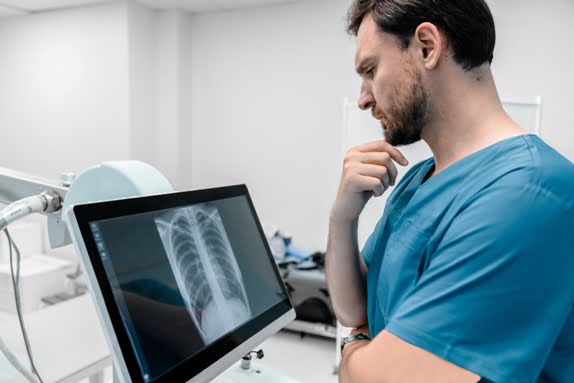What is a Chest X-ray AP/LAT View?
The chest X-ray is typically performed in two standard views: Anteroposterior (AP) and Lateral (LAT). The AP view is often taken as a standard frontal (or "front-facing") image, while the LAT view is a side view. These two projections allow the radiologist to visualize the chest from different angles, improving the diagnostic accuracy for detecting abnormalities such as lung diseases, heart enlargement, infections, and other thoracic conditions.
1] Anteroposterior (AP) View: In the AP view, the X-ray beam passes from the front (anterior) to the back (posterior) of the body. In most cases, the patient stands facing the X-ray machine, with the chest against the film or detector. For hospitalized patients, especially those who are bedridden, an AP view can also be obtained while the patient is lying down, though this is less ideal due to potential distortion from the supine position.
2] Lateral (LAT) View: In the LAT view, the X-ray beam passes from one side of the body to the other. This is typically taken with the patient standing with one side of the chest against the detector. The lateral view is valuable in providing a clear view of the heart, mediastinum, and the posterior parts of the lungs, which may be difficult to visualize in the AP view.
Importance of AP/LAT Chest X-ray
Together, the AP and LAT views offer a more complete picture of the chest cavity than either view alone. These two projections are especially helpful for evaluating various medical conditions, including:
1] Pulmonary Diseases: Conditions such as pneumonia, tuberculosis, emphysema, and lung cancer can often be identified through characteristic patterns seen in both the AP and LAT views. For example, in the case of pneumonia, the AP view may show consolidation or opacities in the lungs, while the LAT view can reveal whether the infection is localized or spread to other parts of the lung.
2] Heart Disease: The chest X-ray is a critical tool for assessing the size and shape of the heart. In an AP view, cardiomegaly (enlargement of the heart) can be detected by changes in the contour of the heart. The LAT view helps evaluate the heart’s shape, particularly the posterior and lateral borders, which are not easily visible in the AP view.
3] Fractures and Trauma: The AP and LAT chest X-ray views can help detect rib fractures or other traumatic injuries to the chest. The lateral view is particularly useful for identifying fractures that may not be visible in the AP view due to overlapping structures.
4] Foreign Bodies and Obstructions: Both views are important for identifying foreign bodies or obstructions in the airways. The AP view may show the presence of a foreign object, while the LAT view can help determine its exact location in the trachea or bronchial tubes.
5] Pleural Effusion and Pneumothorax: Conditions such as pleural effusion (fluid accumulation in the pleural space) and pneumothorax (air in the pleural cavity) are often detected in chest X-rays. The lateral view can help identify the presence of a pleural effusion, which may not be as clearly seen in the AP view. Similarly, the AP view can show the classic signs of a pneumothorax.









